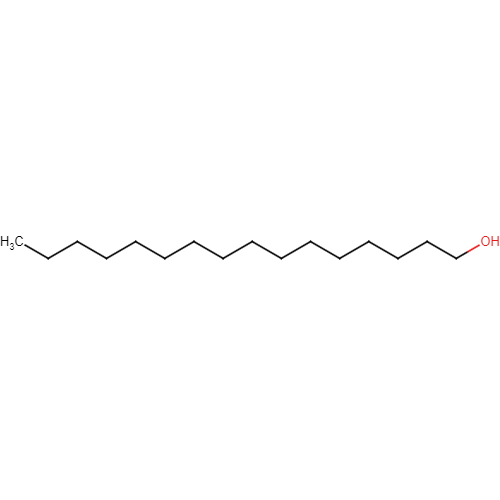1-Hexadecanol
| Compound Structure: |

|
||||||||||||||||||||||||||||||||||||||||||||||||||
|---|---|---|---|---|---|---|---|---|---|---|---|---|---|---|---|---|---|---|---|---|---|---|---|---|---|---|---|---|---|---|---|---|---|---|---|---|---|---|---|---|---|---|---|---|---|---|---|---|---|---|---|
| Synonyms: | 1-Hexadecanol;cetyl alcohol;Hexadecan-1-ol;36653-82-4;HEXADECANOL;Cetanol;Palmityl alcohol;Hexadecyl alcohol;N-Hexadecanol;n-1-Hexadecanol;n-Cetyl alcohol; Cetaffine; Cetylol; Ethal;Ethol; Cetylic alcohol; n-Hexadecyl alcohol; Cetal;Crodacol C; Loxanwachs | ||||||||||||||||||||||||||||||||||||||||||||||||||
| Compound ID: | NMPC-080 | ||||||||||||||||||||||||||||||||||||||||||||||||||
| PubChem ID: | |||||||||||||||||||||||||||||||||||||||||||||||||||
| Molecular Formula: | C16H34O | ||||||||||||||||||||||||||||||||||||||||||||||||||
| Canonical SMILES: | CCCCCCCCCCCCCCCCO | ||||||||||||||||||||||||||||||||||||||||||||||||||
| InChIKey: | BXWNKGSJHAJOGX-UHFFFAOYSA-N | ||||||||||||||||||||||||||||||||||||||||||||||||||
| About the compound: | Cetyl alcohol, also known as hexadecan-1-ol or palmityl alcohol, is a fatty alcohol with 16 carbon atoms (C-16) and the chemical formula CH3(CH2)15OH. It typically appears as a solid or waxy white substance at room temperature, and it was originally derived from whale oil, hence the name "cetyl" derived from "cetacea" or "whale." The discovery of cetyl alcohol dates back to 1817 when French chemist Michel Chevreul heated spermaceti, a waxy substance from sperm whale oil, with caustic potash. In modern production, cetyl alcohol is typically obtained through the chemical reduction of ethyl palmitate rather than from natural sources. Cetyl alcohol finds application in various industries. In the cosmetic sector, it acts as an opacifier in shampoos and serves as an emollient, emulsifier, or thickening agent in the production of skin creams and lotions. It is also used as a lubricant for nuts and bolts and is the key ingredient in some "liquid pool covers," which create a non-volatile surface layer to reduce water evaporation, conserve heat, and reduce latent vaporization heat loss in swimming pools. Additionally, it can function as a non-ionic co-surfactant in emulsion applications. Hexadecan-1-ol is a related long-chain fatty alcohol, with a hydroxy group at position 1 in a hexadecane molecule. It plays roles as a human metabolite and an algal metabolite. This compound is classified as a long-chain primary fatty alcohol and is often referred to as a fatty alcohol 16:0. Cetyl alcohol, also known as 1-hexadecanol or n-hexadecyl alcohol, is a 16-C fatty alcohol (CH3(CH2)15OH) that can be obtained from the reduction of palmitic acid. It is typically found in a solid or flake form at room temperature and is insoluble in water while being soluble in alcohols and oils. Cetyl alcohol is one of the earliest known long-chain alcohols, discovered by Chevreul in 1813. It is frequently used in cosmetics and personal care products such as shampoos, creams, and lotions. Its versatile functions include opacifying, emulsifying, and thickening, which alters the consistency of liquids and enhances their foaming capacity. Due to its ability to bind water, cetyl alcohol is a common emollient that prevents skin from drying and chapping. The U.S. FDA has recognized cetyl alcohol as a safe synthetic fatty acid in food production as long as it contains not less than 98 percent of total alcohols and not less than 94 percent of straight-chain alcohols. Furthermore, cetyl alcohol is listed in the OTC ingredient list as a skin protectant for skin irritations caused by poison ivy, oak, sumac, and insect bites or stings. However, it is reported to be a mild irritant to the skin or eyes in some cases. GHS Hazard Statements • H315 (31.63%): Causes skin irritation [Warning Skin corrosion/irritation] • H319 (74.87%): Causes serious eye irritation [Warning Serious eye damage/eye irritation] • H335 (12.35%): May cause respiratory irritation [Warning Specific target organ toxicity, single exposure; Respiratory tract irritation] • H400 (28.43%): Very toxic to aquatic life [Warning Hazardous to the aquatic environment, acute hazard] • H410 (14.8%): Very toxic to aquatic life with long lasting effects [Warning Hazardous to the aquatic environment, long-term hazard] • H411 (28.22%): Toxic to aquatic life with long lasting effects [Hazardous to the aquatic environment, long-term hazard] • H412 (25.03%): Harmful to aquatic life with long lasting effects [Hazardous to the aquatic environment, long-term hazard] • H413 (28.43%): May cause long lasting harmful effects to aquatic life [Hazardous to the aquatic environment, long-term hazard] |
||||||||||||||||||||||||||||||||||||||||||||||||||
| Properties: |
Chemical and Physical Properties
Source: PubChem |
||||||||||||||||||||||||||||||||||||||||||||||||||
| Source Species: |
Gongronema latifolium Petiveria alliacea Scleria depressa Tithonia diversifolia Brachystegia eurycoma Moringa oleifera |